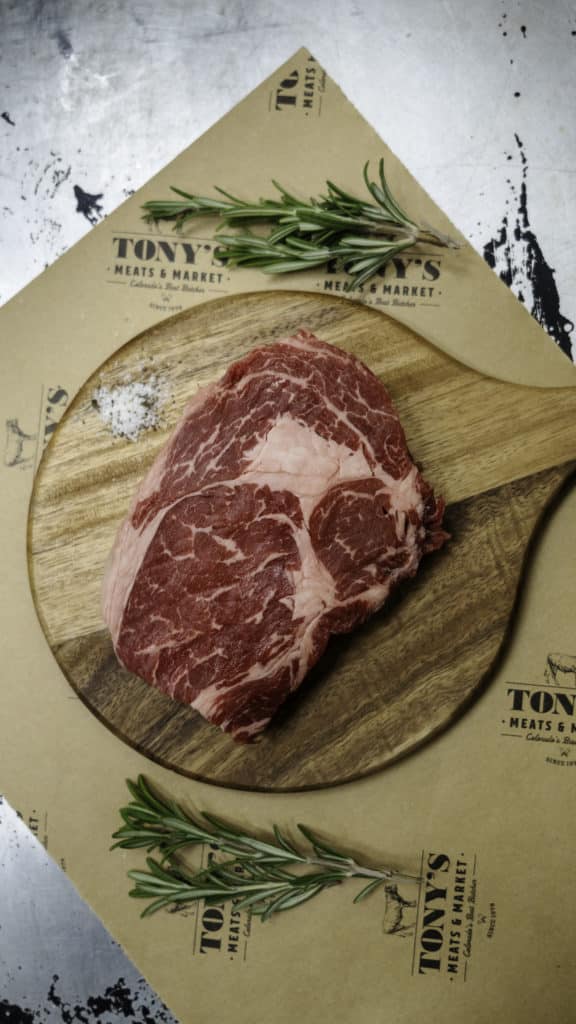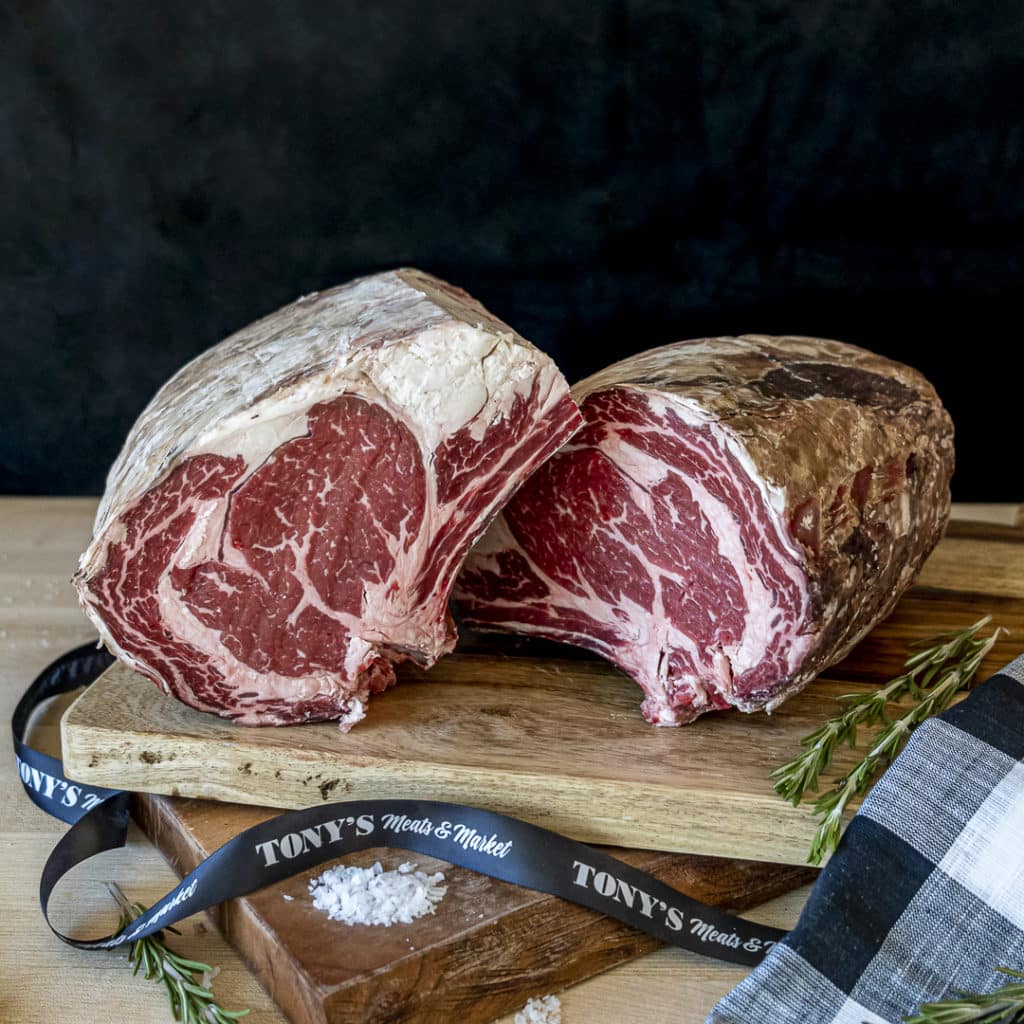What makes Beef great?
As an insider, I get irritated with beef commercials. These big chains all claim to have “the
juiciest and most tender beef for less”, but I know it’s simply not true. News Flash… Better quality costs more and the only way to reduce price is to reduce quality – period!
Apparently facts mean nothing in the world of marketing. Folks have been misled so often and for so long they either start to believe the lies or just go numb from overload. Want to be a savvier shopper? Here are the facts every consumer should know about choosing beef, and about our beef at Tony’s. Follow along to see what makes beef great!
Tony’s Natural Local Beef
Great beef is the backbone of our meat departments, so we go to great lengths to assure we have the finest beef possible in our markets. Read on for the facts about Tony’s Natural Local Beef.

Marbling is a key quality factor.
USDA High Choice and Prime Grade
We proudly cut steaks from the top 10-13% of local premium beef, a combination of High or Premium Choice and USDA Prime grade beef. Read more about USDA Beef Quality Grades in the next section.
Natural – No ‘Enhanced’ Meats
Our beef has had nothing added and is designated as Natural by the USDA. Pumping, injecting or vacuum marinating meats with water, phosphates and chemical flavoring solutions is a very common practice; it’s estimated 70% of meats in stores and restaurants contain additives (and most don’t even know it). These ‘enhancing’ techniques increase weights from about 15-50%. You will never find enhanced meats at Tony’s Markets!
Locally Raised
We live in some of the best cattle country in the world, and we only buy natural meat raised by approved local family ranchers, generally less than 300 miles from our markets. Raising high-grade beef is not easy and requires lots of healthy land, grasses and clean water – so quality-minded (rather than bulk minded) ranchers with access to these lands are approved by and work closely with our processor to carefully track lineage, feeding, health and animal husbandry in great detail. The definitive proof of quality is obvious in the final product; so the entire history of the very best quality beef is shared with ranchers in the program to consistently produce the best meat possible.
Grass Feeding and Grain Finishing Means Great Beef!
Our beef ranges freely on irrigated grasslands and non-irrigated rangelands and is constantly rotated to assure the lands are not overgrazed. Eventually, our beef is finished for about 3 months on a veterinarian planned and constantly changing diet of grains, natural silage and local crop surpluses (think beet tops) before harvesting.
This combination of feeding methods gives us the best quality beef possible, and assures sustainability.100% Grass Fed Meats We also proudly offer 100% Grass Fed Local Beef of exceptional quality, it took us many years to find a 100% Grass Fed Ranch of this quality – read more and meet the rancher here.

Cattle grazing irrigated pasture.
No Hormones, Antibiotics or Pesticides
To assure there are no chemical residues and verify proper raising of our beef, chemical testing is performed on organs like the liver where they are most likely to be found. We proudly offer beef (and other meats) without additives of any kind, and no chemical, hormonal or antibiotic residues. In order to verify this and maintain the certification required by our program, organ meats (such as the liver) are lab tested for chemical residues by the packer. We also do random lab testing of our meats on our own and have never found any chemical residues.
Humane Treatment
Superior animal husbandry is the rule and one of the secrets to raising great beef, ill treated animals could never achieve the quality levels our guests demand. Our approved and inspected small family growers always treat their animals in a kind and humane manner, nothing could be more important to a responsible rancher.
Extended Aging
No Gassed Meats or Meat Glue
In-House Ground Meats
Our ground meats have never and will never contain bulk meats, pre-ground meats, outside carcass trimmings, additives, by-products, extenders or meat pastes from automatic meat recovery systems (AKA ‘Pink Slime’ – get more details here).We grind in small batches several times each day and only use whole muscle cuts like chuck roast with our own steak and roast trimmings. Our ground chicken and turkey meats, ground pork and homemade sausages are are always all natural and whole muscle. We never use by-products, skin, fillers, chemicals, preservatives or additives of any kind. We also regularly tour and inspect all our suppliers to assure all our meats are of the highest quality and safety, and that they are never treated with chemicals or additives of any kind before they reach our doors.
USDA Beef Quality Grades
The USDA offers an inspection service to rate the potential quality of beef to help the consumer
with a consistent set of quality standards. At Tony’s, we will only sell USDA inspected beef (and all meats). Many grocery chains skip this step to save money, but still represent their beef as graded (for shame!).
USDA Prime
This is the highest grade of beef, and only about 2% of all American beef can achieve this lofty grade. USDA Prime beef has to meet a lot of strict quality standards, most notably a very high level of marbling. Marbling is the streaks of fat inside the center of the muscle, and the more and finer the streaking, the higher the marbling level. Prime beef is the juiciest and most flavorful beef possible, and is available nicely aged at Tony’s Markets.
USDA High Choice (AKA Premium Choice, Top of Choice and Choice Plus)
USDA Choice is a very wide category so it’s broken down into sub-categories of quality for the professional beef buyer: High Choice (other common names listed above), and Low Choice. High Choice beef is wonderfully marbled for the best flavor, juiciness and tenderness – but only about 10% of beef can achieve such a high grade. Low Choice has far less marbling and makes up about 90% of the beef graded as Choice. We proudly age and cut steaks with High Choice beef as well as Prime Beef.Our guests also tend to be very health conscious and we listen, so to better control overall fat contents we also choose premium local meats with less marbling for lower fat levels on richer cuts such as Chuck Roast, and to keep our Ground Beef nice and lean.
USDA Select
Previously called ‘Generic’ beef. USDA Select beef is a very low grade and the steaks are not recommended for grilling. To improve quality, it’s often mechanically and/or chemically tenderized by injection and vacuum machines (these enhancing methods can add up to 20%
weight).

Beef Branding
Marketing a beef brand is common these days – skipping the facts and using a nice sounding name makes it confusing for customers (which is good for bulk retailers). One well-known
example is Certified Angus; thanks to extensive national marketing, it’s become synonymous with quality in the minds of most.
What most folks don’t know is that the Certified Angus Program has nearly 2-dozen quality levels – from very high grade to not so great. We do not advertise a brand at Tony’s. Instead, we select beef based on our own set of quality standards, some of the most rigid in the industry!
RECIPE
Rib Eye Steaks with Gorgonzola and Port Wine Sauce
4 Rib Eye Steaks, Premium grade and aged 3-4 weeks
2 TBS minced garlic (optional)
1 TBS olive oil
2-3 TBS Tony’s Euro-Crust or Z Blend Seasoning
4 TBS gorgonzola cheese – room temperature
Garnish: fresh blackberries or raspberries and mint sprigs (optional)
Port Wine Sauce:
1 cup instant demi-glace (More Than Gourmet brand)
1 TBS olive oil
1/4 cup minced shallot
1 cup Port wine
1 TBS butter
Combine garlic and olive oil and rub over steaks. Sprinkle with seasoning to taste. Preheat a medium high grill.
Cooking Outdoors:
Grill over direct heat, cooking to rare / medium rare. Remove to a plate. Crumble gorgonzola with two forks and sprinkle over steaks – tent with foil and rest for 5-10 minutes.
Cooking Indoors:
Preheat oven to 375° and preheat a heavy oven-safe skillet or grill pan over medium-high heat (cast iron is ideal). Mist pan with oil and brown steak well on the first side. Turn, transfer to oven and finish cooking to desired internal temperature (115-135° internal suggested for rare to medium – can also be cooked from start to finish in the pan over medium heat). Remove from oven, transfer to a plate, top with gorgonzola and tent with foil. Rest for 10 minutes before slicing and serving.
Meanwhile, prepare demi-glace according to package directions, set aside. In a saucepan, saute minced shallots in oil until soft. Add Port and reduce by half. Stir in demi-glace and simmer several minutes to marry, keep warm, or rewarm when ready to serve. Swirl in butter immediately before serving.
Serve steaks drizzled with Port wine reduction sauce. Garnish with dark berries and mint or oregano sprigs if desired.
Comments are closed.




